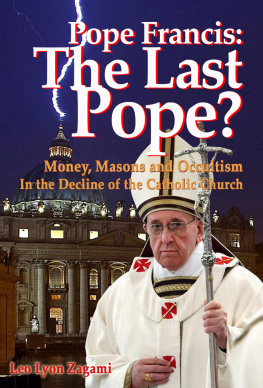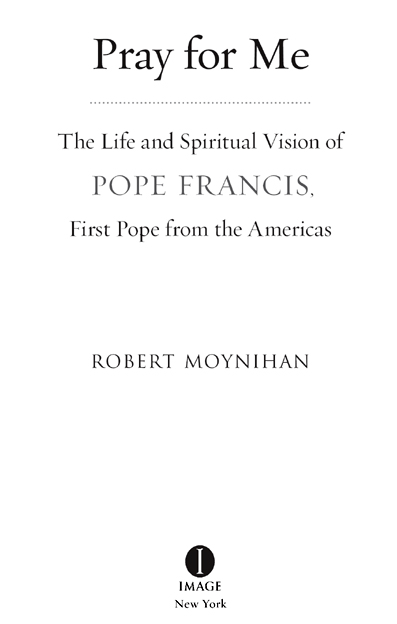Copyright 2013 by Robert Moynihan
All rights reserved.
Published in the United States by Image,
an imprint of the Crown Publishing Group,
a division of Random House, Inc., New York.
www.crownpublishing.com
I MAGE is a registered trademark, and the I colophon is a trademark of Random House, Inc.
A complete list of permissions appears on .
Library of Congress Cataloging-in-Publication Data is available upon request.
eISBN: 978-0-307-59076-3
Front jacket photograph: Associated Press
v3.1
CONTENTS
PART ONE
A New Popes First Days
PART TWO
The Life That Formed Pope Francis
PART THREE
In His Own Words
PREFACE
When Pope Francis stepped out on the balcony of St. Peters Basilica for the first time on the cool evening of March 13, 2013, the people in the square below and those watching around the world asked themselves: Who is this man? What does he believe? What will he do as the leader of the Church?
This book hopes to provide starting points to answer some of those questions.
Written in the two weeks after the papal election, Pray for Me is partly my eyewitness account of those early days. During that time I was present in Rome for his initial meeting with journalists, his first Angelus, his first Wednesday audience, the March 19 Mass inaugurating his pontificate, the Palm Sunday Mass on March 24, the Easter Vigil Mass on March 30, and the Easter Sunday Mass on March 31, 2013. The first part of this book is a collection of dispatches from the front, if you will. Here is a bit of history in the making, captured as it was happening, in order to root the story of Pope Francis in facts, rather than speculation about what he might do in the future.
This is followed by two other parts that introduce readers to the man, his life, and his spirit, based primarily on his own words and the words of those close to him. First, a brief biography provides a context for understanding this mans origins: from his childhood in Buenos Aires to his assuming the Chair of Peter at the age of seventy-six. This section also includes a look at the spiritual influences behind the actions taken by this dedicated priest. The last part is a collection of his words on various subjects, offering a glimpse of Pope Franciss thoughts on fundamental philosophical and theological issues. This is a window into his understanding of the ultimate questions of importance to the human soul: What is faith? What is hope? What is joy?
I approached this material as a journalist, but also as a believer. While I have tried to present a clear journalistic approach to the material, my main goal was to offer readers a tool that can be used in many ways as a devotional. Written in the spirit of lectio divina, or reading (in this instance, writing) in a prayerful manner, you will certainly find ample information on the whos, whats, and wheres of Pope Franciss life. But Pray for Me is really geared for those who would like to accompany Pope Francis on his journey of faith in the months and years ahead. You may certainly read this book cover to cover, but I encourage you to use it as a tool for contemplation, one in which you can turn to any page and open a space for prayer and meditation on Pope Franciss lifeand yours as well.
And that is the central point of this book: It offers readers an opportunity to journey alongside this new pope, not only by walking with him in the first days of his papacy, but also by allowing readers to experience the soul of this man, his strength, passion, and tenderness.
Case in point: The morning of March 31, 2013, on Easter Sunday, Pope Francispope for just two and a half weekswas riding through the vast crowd in St. Peters Square when he came upon a young boy suffering from cerebral palsy. I was standing just a few feet away and watched as Pope Francis reached out of his jeep, embraced the child, and kissed him on the cheek. There, in the midst of thousands, he held the boy, whose parents and friends had raised up with extended arms. This was not a photo opportunity but an act of love that left many who witnessed it in tears. The inner man performing an outer act of love was a prayer in the greatest sense of the word.
So this book is intended to help those who are responding to the first request made by this pope to all of us, a simple request, from his heart: Pray for me. Pope Francis is aware of his own frailty, his own imperfection, his own humanity. He knows that he needs the prayers of others, as we all do. He knows that the prayers of others can support him spiritually to be and to do, as a successor of Peter, what he must be and must do. In calling for prayers for himself, Pope Francis asks us as a community to care for the poor, for those treated unjustly, for the imprisoned and the suffering, for those who have lost hope, and also for him, that he may carry out his task with courage and humility.
If this book, Pray for Me, will help to create such a community, it will have served its purpose.
Rome, April 2, 2013
INTRODUCTION

The Spirit of Pope Francis
The world was astonished at the simplicity of the man. When he appeared on the balcony of St. Peters Basilica in Rome at 8:24 P.M. on the evening of March 13, immediately after his election as the new pope, he was dressed all in white, only white, without the traditional red mozzetta, the elbow-length red cape, often trimmed in ermine, worn by the Roman pontiff over his white cassock. (We later learned that his assistant, the papal master of ceremonies, Monsignor Guido Marini, had placed the red cape on the new popes shoulders, but that he had shaken his head and said, No.)
He stood silently for a while, gazing out over the crowd of some two hundred thousand. He did not speak.
It was this silence that struck all of us, because all of us understood that no words, whether few or many, could fully express all that might need to be said, all the feelings, all the hopes, all the concerns, of that man, at that moment. There was a modesty in his silence, and a wisdom; a modesty in recognizing that whatever words he chose might not measure up to the significance of this moment, a wisdom to know that simply standing there, all in white, was already an expression of who he was, and what he intended to do.
His silence was eloquent, and his smile told us that he was with us, waiting with us, standing with us. His silence spoke to us.
In St. Peters Square, onlookers had been gathering for an hour, as the news that white smoke had spilled out of the chimney of the Sistine Chapel at 7:06 P.M. had spread through the city.
Many had not expected the election to come so soon. There had been black smoke the previous day, the first day of the conclave, at 7:42 P.M. , signaling an initial failed vote. And in the morning, at 11:40, the second fumata nera (black smoke) arrived, signaling two more inconclusive votes. When no smoke had come by 6:00 P.M. , we understood that there had been a fourth failed vote, and many felt that there would be black smoke again, and no pope until the next day, or the next.
So when the white smoke billowed out, there was much surprise. The conclave had ended rather quickly. The cardinals had decided. Had they elected Angelo Scola of Milan, another Italian after two foreign popes? Odilo Scherer of So Paulo, Brazil? Marc Ouellet of Canada? Gianfranco Ravasi, the biblical scholar who had been the head of the famous Ambrosian Library in Milan? Had they made a radical departure from tradition and chosen a man from the Far East, like Luis Tagle of Manila or Malcolm Ranjith of Colombo? Had they perhaps even taken the revolutionary step of choosing an American, and if so, who was it? The jovial, bighearted Cardinal Timothy Dolan of New York? The more reserved Capuchin friar from Boston, Sean OMalley, who had won the hearts of the Italian people in previous days with his Franciscan simplicity, and who was known as a Latino because of his knowledge of Spanish and his work with Latin American immigrants to the United States?













